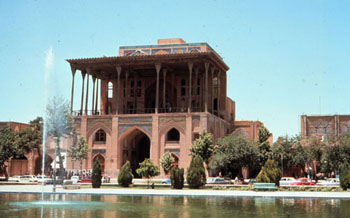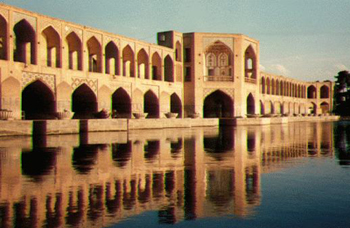|
|
|
|
|
|
|
PersianIran.com |
||||
|
|
|
|
|
|

ESFAHAN
The province of Esfahan (also spelled Isfahan) lies on the Zayandeh River, almost in the heart of Iran. This city, once the capital of Iran, is now only the administrative headquarters of the province. It lies about halfway between Tehran and Shiraz, at about 400km south of Tehran.Esfahan has been designated as a world heritage by UNESCO. It has some of the oldest architecture in the world that dates back to the 10th century. The cool blue tiles of Esfahan's Islamic buildings, and the city's majestic bridges, contrast perfectly with the hot, dry countryside around it. Esfahan is a sight you won't forget. Not only is the architecture superb and the climate pleasant, but there's a fairly relaxed atmosphere here. It's a city for walking, getting lost in the bazaar, dozing in beautiful gardens and meeting people.
The famous half-rhyme Esfahan nesf-é jahan (Esfahan is half the world) was coined by the French poet Renier in the 16th century. He believed that half the beauties of all the world is to be found in Esfahan, so overwhelmed was he by his experiences of the city. There's so much to see in Esfahan that the visitor will have to ration his time and concentrate on must-sees such as the Shah Square, one of the largest town squares in the world. Taking tea in one of the teahouses under the bridges is also an essential part of the Esfahan experience.
Of all the cities in Iran, Esfahan is perhaps the richest in historical and architectural wealth. In 640 AD it was conquered by the Muslims. During the Islamic era, it has endured battles and dreadful setbacks and it has seen prosperous times.
The city's golden age began in 1598 when Shah Abbas the Great made it his capital and rebuilt it into one of the largest and most beautiful cities of the 17th century. In the centre of the city he created the immense Meydan-e Shah (Royal Square) as well as the noted Masjed-e Shah (Royal Mosque), which was not finished until after his death, and the Masjed-e Sheykh Lotfollah (Lotfollah Mosque). The Safavid Kings ruled nearly 150 years and this city was their capital. Schools, mosques, and magnificent buildings were built, while science, architecture, handicrafts, decorative arts, calligraphy and miniature paintings flourished. Esfahan was given the title of half of the world and It's reputation soon spread throughout the civilized world.
Fortunately, most of Esfahan's former glory survives or is being restored. New parks, roads, colleges and factories (including a massive steel mill) have also been built in recent years.
Important places :
| Chehel Sotun or Forty Pillars was built by Shah Abbas II as a hall of audience for official functions. It contains a garden covering an area of 26 acres. Today, the building stands among ancient trees in a large portion of the original garden. The immense verandah of the palace sits by a huge pool which reflects the numerous columns. The upper part of the large audience hall is covered with paintings showing such scenes as Shah Abbas feasting and Shah Ismail and Shah Tahmasp entertaining Homayoun the King of India. On the walls of the other rooms there are miniatures, portraits and works of eminent master artists of the period. | 
|

|
Meydan-e Emam - The Emam square (former Shah square) :
Before Shah Abbas I the Great rebuilt this square there used to be a much smaller square called Naghsh-e Jahan - The Design of the World. Built at the beginning of the 17th century and bordered on all sides by monumental buildings linked by a series of two-storeyed arcades, the site is known for its Royal Mosque, the Mosque of Sheykh Lotfollah, the magnificient Portico of Qeyssariyeh and the 15th century Timurid Palace. All bear witness to Persian socio-cultural life during the Safavid era. the square is 500 metres long and 150 metres wide. It was originally conceived as a polo ground and open square in front of the Royal Palace of Ali Qapou, but was re-designed this century to include the formal lawns and large pool. |
The Ali Qapoo Palace is situated to the west of Naqsh-e-Jahan Square. Its name means The High Gate and its impressive entranceway was no doubt intended to symbolize the strength and authority of the Safavid monarchs. It was used for the reception of the ambassadors and envoys from other countries. Ali Qapoo is a six story building with numerous rooms. The plasterwork and paintings are extremely impressive.
The talar or verandah formed an ideal place from which to watch the games of polo which took place in the square and is richly decorated with designs painted on the external plaster at the rear and elaborate tracery in the ceiling. The columns, like those of Chehel Sotoon, were originally encased in mirrored glass to give the impression of a roof floating in the air, and like them are cut from single chenar trees. The interior of the building is compulsively decorated with naturalistic scenes, charmingly painted birds and some figures, many of which have sadly been defaced or damaged over time. These are now being repaired. The famous Musicians Room contains elaborate cut-out plaster work depicting all manner and shapes of vases, although it is doubtful whether any could ever actually have been stored there. |

|
The Khaju bridge was built by the order of Shah Abbas II at the entrance of the Esfahan-Shiraz road. Its storied recesses, galleries and arcades, the splendid tile-work, the arches of the upper booths and lower spans, and particularly the alcoves located in the center are the important features of this bridge. |
|
Si-o-Seh Pol (the 33 bridge) or Pol-e-Allahverdi Khan :
This bridge is one of the historical monuments of Esfahan and was constructed in the south of Chahar Bagh Street over Zayandeh Rud. It consists of 33 arches and was constructed with bricks (300 m long and 14 m wide) in 1602 A.D. by the order of Shah Abbas 1 and by Allahverdi Khan. |

|